“Has Gomphrena globosa ever gained such substantial attention in the Japanese flower market before? Currently, it enjoys considerable popularity.” While perusing the Unchiku Exploration Team’s diary, I stumbled upon a hastily scribbled note I had penned.
Certainly, one might wonder if there has ever been such a conspicuous presence of the Gomphrena globosa at the Ota Market in the past. Yes, it might be but, it’s unlikely that Gomphrena globosa was used extensively in beautiful bouquets designed as trendy items as it is today. It used to be associated with autumn equinox offerings at Buddhist altars when it came to cut flowers, but when did it start being used like this?
First, let’s take a look at some numbers related to Globe Amaranth.
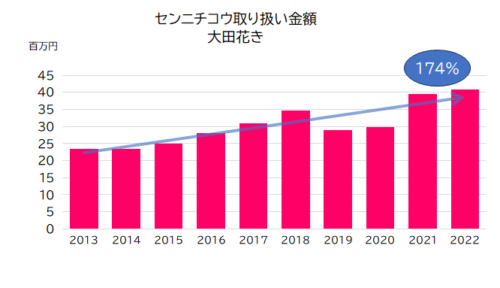
[Gomphrena globosa’s price chart. X-axis: year; Y-axis: millions of Yen]
From 2013 to 2022, the financial performance of trading amounts has increased by 174%. Although the volume in number of Gomphrena globosa handled in Ota Flower Market has remained almost the same (100%). The increase in the monetary value suggests that either the market has grown larger or there has been some change from the traditional market.
While domestic cut flower production has been declining along with what’s been called Japan’s “Lost 30 Years” of the economy, what’s up with this growth? Even in an overall decrease, isn’t this increase phenomenon that seems to ignore the overall trend a bit puzzling?
↓The green bar indicates the domestic cut flower supply (in stems) according to the Ministry of Agriculture, while the pink bar represents the Gomphrena globosa flower received by Ota Kaki.

[Chart of Gomphrena globosa production amount in the global cut flower market. X-axis: year; left Y-axis (pink bar): hundred thousand of Gomphrena globosa, right Y-axis (green bar): millions of Gomphrena globosa]
While the domestic cut flower industry is on the decline, Gomphrena globosa is on the rise.
An audience once came up to me and said,” This is quite an outstanding number. Furthermore! Gomphrena globosa has won the Flower of the Year OTA 2022 award! Who is the producer?”
It says “Sanada Flower.”
After identifying the producer, I paid a visit to Sanada Flower in September, a key figure potentially responsible for the recent success of Gomphrena globosa.
↓We arrived in Minamiboso City, Chiba. It’s located at the very tip of the Boso Peninsula, on the eastern side and just 1.5km away from the sea.
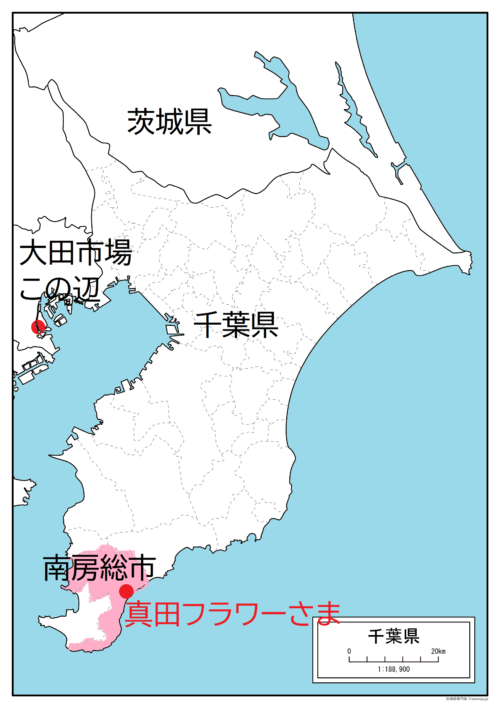
[Otakaki (left) and Sanada Flower (right) location]
We took the Aqua Line from Ota Market, and it’s about a 1.5-2-hour drive from there.
This is Mr. Kazuhiro Sanada of Sanada Flower, the third-generation flower producer.

[Mr. Sanada]
◆Basic Information: Sanada Flower◆
– Products: Gomphrena globosa, Antirrhinum majus (all cultivated in greenhouses), currently focusing on globe Amaranth
– Varieties: One variety of Gomphrena globosa (Rose Neon only), five varieties of Antirrhinum majus
– Production Area: 25 greenhouses, approximately 4960 square meters
– Workforce: Mr. Sanada’s family of four, three full-time employees, seasonal temporary staff
– Resemblance: Mr. Kazuhiro Sanada looks like TUBE’s Wataru Maeda, especially when smiling (personal impression, but likely shared by many).
Succeeding through generations as a flower specialist, Mr. Sanada’s father produced Oncidiums, Limonium sinuatum, Brassica rapa, Antirrhinum majus, and more. Mr. Sanada’s Grandfather specialised in producing and selling Calendula officinalis seedlings.
Opening Sanata Seeds’ catalogue, I saw “Sanada Shin-Kuro.” This must be the breed Mr. Sanada’s grandfather made. “Exactly,” said Mr. Sanata. He is quite an enthusiast for horticulture, specifically focusing on breeding thoroughbred plants.
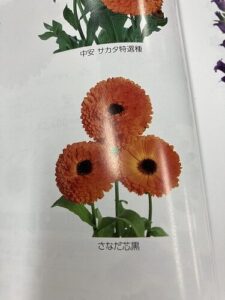
[Sanada Shinkuro]
★Gomphrena globosa
– Origin: Tropical America
– Scientific Name: Gomphrena globosa
– English Name: Globe Amaranth
Globe means “spherical,” and Amaranth comes from the Greek word meaning “unfading.” Derived from “a” (negation) + “maraino” (means “to wither”), which can be translated into “flower that never withers.”
– Note: When we call it a flower, we are actually referring to the colourful bracts. The actual flowers wither quickly, but the bracts that form the flower head remain colourful for a long time. Because of its durability, this kind of flower also has the meaning of “unchanged” in English.
★What Sets Sanada Gomphrena globosa Apart?
Before delving into Mr. Sanada’s insights, let’s highlight several points that make his Gomphrena globosa (referred to as “Sanada Globe”) different from the others:
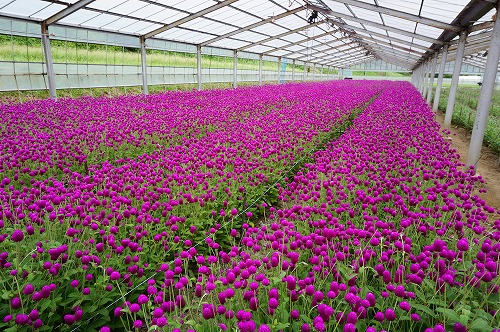

– High quality and well-bloomed in every flower bud
– Consistent number of flowers on each stem
– Consistent position of flowers
– Moderate flower size for easy use
– Exceptional shelf life
– Sturdy, wire-like stems
– No wilting
– Straight branches
– Easy to use
– Standardized size and appearance across all boxes
(Please let me go on to the next because there are too many advantages…..)
Now, let’s discuss one crucial aspect that truly defines Sanada Gomphrena from the list above —- Sturdy stems. The stems are incredibly strong. They are impressively firm and can be described as steel wire. Of course, I believe a scientific analysis would classify them as plant material, though.
In fact, please take a look at the dried flower version of Mr. Sanada’s Gomphrena globosa.

This is what it looks like without being upside down.
Or rather, there is no need to be turned upside down because of the wire-like stem.
While drying a normal flower, the flower should be turned upside down in order to drain the water out during the process. If not, the flower neck can be bent down due to the softened stem. But in the case of r. Sanada’s Gomphrena globosa, keeping it standing like this, we can notice that it is beautifully dried and still.
Just as the name suggests (in Japanese), the colouring and sturdiness are as if they embody the red colour of Gomphrena globosa for a thousand days.
Because of the speciality, I would like to explore the secret behind this.


[Views of the Gomphrena globosa greenhouse]
Upon visiting the farm, I met a sea of pink Gomphrena globosa under the heat. Despite the extraordinary view, I was drenched in sweat without moving a finger.
“During summer, it can reach up to 45 degrees,” Mr. Sanada mentioned.
“Even when the air flows well enough?” I asked.
He nodded and said, “This summer might have been even hotter.”
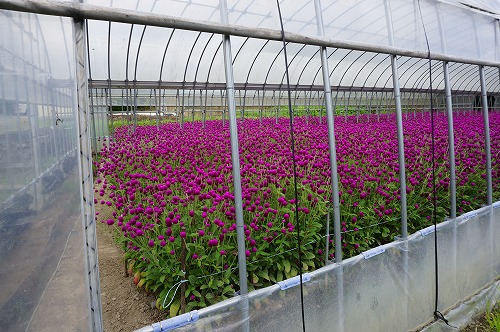

Although the heat was scorching, Sanada Gomphrena globosa continued to bloom beautifully. So, what’s the key to their wire-like stems?
“It’s all about cutting off water. We avoid watering them before shipping-out.”
I wondered, “For how long do you withhold it?”
“Three weeks to a month.” Mr. Sanada answered.
I was surprised by the answer, “Like… a whole month without water?”
“Not a single drop. No fertilizer either. Absolutely nothing.” said Mr. Sanada.
Nothing at all? That’s incredible. Still, the cracked ground in the greenhouse due to excessive dryness has proved what Mr. Sanada just said.


I’ve visited many producers’ farms before, but I’ve never seen fields with cracks under such drought. Is it safe to withhold water for so long?
“It’s necessary. If we don’t, the stems that absorb water may turn soft. This makes it difficult to work with and can reduce their life after being harvested. Moreover, by limiting water during cultivation, we can control the growth of side branches, ensuring uniform flower potionings on the stems.”


In order to position the bud tip at the centre of the plant, we need to restrain the lateral branches’ growth, ensuring that all the flowers are at the same height. If the lateral branches extend too much, it results in flower heights and sizes affected, as well as making the stems less sturdy.
“It’s easier to use them for any purposes if the bud tip is at the highest point, as well as if the heights of the other flowers are roughly the same. While managing water in the greenhouse, unlike an open ground, rainwater doesn’t affect it therefore allows better control of irrigation.”
Cutting off water results in uniforming flower heights and leads to large, elegant flower heads. It is clear that we can all see such attributions in Sanada Gomphrena globosa than in conventional Gomphrena globosa.
“It’s better not to let them grow too big. They tend to get larger during this season.”
Wow, is this what Gomphrena globosa is supposed to look like? The impact is truly impressive.


“It’s similar to how tomatoes develop sweetness when restricting water during cultivation. Cutting off water allows Sanada Gomphrena globosa to store nutrients and achieve this appearance.”
Cutting off water leads to uniform flower heights that avoid extra branches and result in wire-like stems and larger flowers.
“Take a look at the leaves below which have already turned yellow.”
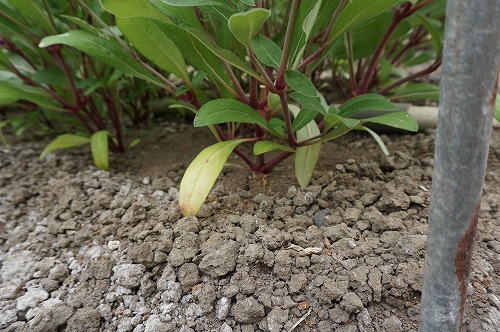
“This is the sign of hunger. But we continue withholding water and cutting off fertilisers — giving the plants nothing.”
★Why Sanada Gomphrena globosa?
At any rate, there are still some aspects that we cannot understand. To be honest, the question that has been bothering me is —- why would Mr. Sanada choose to cultivate Sanada Gomphrena globosa instead of big-ticket items like Lisianthus, Helianthus, or spray Chrysanthemums?
“I made this decision because Japan’s summers have been getting hotter each year, and I was seeking flowers that could withstand the heat and dryness. In the first year, I tried growing three varieties, but now I’ve narrowed it down to just Rose Neon. The spray-type Rose Neon looks better and has beautiful colouring compared to the single-stem variety. Therefore Rose Neon has become my choice among all Sanada Gomphrena globosa.”
How astonishing can this be?
It is actually not common at all to engage in farming only a single flower species during the whole season. Producers like Mr. Sanada are quite a rare case. Like, think about it, how popular should the flower be to live from only cultivating one kind of species at a time?!
All of a sudden, Mr. Sanada said, “In the winter, I grew Antirrhinum majus, so I was looking for something to produce in the summer as a side crop.”
Wait, was it always meant to be a side crop? This Sanada Gomphrena globosa…?
“Well, there were already a few places around here producing Gomphrena globosa, so I thought it would be a good fit for a side crop. I was thinking ‘Since some of my neighbours are already growing Gomphrena globosa, why not give it a try?’, therefore I started the project in 2012.”
Even with such an easy reason, the growth in the sales figures of Gomphrena globosa from Mr. Sanada’s farm, which began supplying to Otakaki in 2012 until 2022, is anything but ordinary. The growth of Sanada Flower’s Gomphrena globosa price per year is illustrated in the bar chart below:

[Growth of Sanada Flower’s Gomphrena globosa price per year]
The increase in sales figures is so staggering that it’s hard to believe. It’s a 16,000% increase within a decade, which makes people wonder if the numbers are correct. Yet after double-checking it multiple times, there is no doubt of any inaccuracies. While domestic cut flower production was declining, Sanada Gomphrena globosa was on the rise, and it seems Mr. Sanada played a significant role in this. Sanada Gomphrena globosa is a hit product of the *Reiwa era!
*Reiwa era: The Japanese (imperial) era begins in 2019
“In my opinion, when you’re sticking to creating a particular type of flower, it is often the case that you can’t adapt to time changing. It can be tough if you’re too committed to what you want to create and it doesn’t align with the current trends.
I think some people are okay with that approach. But in my case, I’ve chosen the path of providing what the market needs in a quality that buyers appreciate. In the first place, I don’t particularly love Sanada Gomphrena globosa.”
With such an honest answer, Mr. Sanada also mentioned that his farming philosophy is “it is essential to provide a quality that the market demands and appreciates.”
Indeed not clinging to a specific trend is necessary. When I asked Mr Sanada what he thinks about flower production,
“I don’t particularly love flowers, either.” Well, that’s the second honest answer today.
“At the time, there weren’t many career options. Being the eldest son of a flower-producing farmer in Minamiboso, I vaguely thought it might be my future, and it just happened that way.”
Mr. Sanada’s grandfather started flower production before World War II. At that time, considering flowers as a choice in agricultural production, given the difficulties in domestic food procurement. On top of that, the flower industry was likely unusual, but why did his grandfather choose it?
“Well, Minamiboso City had already been thriving in flower production before that. Flower production had already begun here, so it was quite a normal choice.”
Indeed, Minamiboso City’s emblem is inspired by flowers. If Mr. Sanada is a thoroughbred in flower production, then Minamiboso City must be a sanctuary for flower production.
It seems that flower production and the choice of Sanada Gomphrena globosa were not made with much thought but rather followed the natural flow of time. However, even without a strong attachment to these choices, Mr. Sanada places great effort on the quality and content of his work. Mr. Sanada might have stumbled into flower production, but I believe he would have excelled in any field he chose. His commitment to quality and the neatness of his selection area is one of the best evidence to see the potential.



[The selection area]
Not a speck of dirt is left on the ground of the selection area. The floors and workbenches immaculately shine as if they’ve been waxed. Hygienic conditions also affect the longevity of harvested flowers, and just by seeing this selection area, you can understand the high quality of Sanada Gomphrena globosa.
“I want everything to be clean during the whole process. Customers should receive the same appearance and volume of product every time they open the boxes. That’s how it should be, and that’s what I’m aiming for. Otherwise, you can’t call yourself a professional.”
So we can say that it’s all about the attention to detail, not the specific flower variety.
“The variety doesn’t matter.” Even though Mr. Sanada talks with laughter, his goals are high, and he approaches his work with strict professionalism. This is where you can see Mr. Sanada’s philosophy.
★Reasons Behind Sanada Gomphrena globosa’s Popularity
When we asked him for more details, Mr. Sanada’s greatest concern in Gomphrena globosa production is being “chased by numbers.” In early September, on a certain day during our interview, I had the chance to take a peek at Mr. Sanada’s smartphone screen, which displayed the Olive system (Otakaki Florist’s order processing system). To my surprise, orders were piled up until the final business day of September, the 29th!
Just looking at these numbers can make one gasp from surprise.
Of course, the orders come from wholesalers and florists, but what’s unique about Sanada Gomphrena globosa is the significant presence of supermarkets and big retail chains. When I asked Mr. Watanabe, in charge of ornamental plants at Otakaki, about the reason behind this, he said, “It’s because they stay fresh for a long time. They don’t wilt easily, they don’t gradually become worse in condition, quality, or appearance over time. Not to mention that there’s no trash or bugs, and they remain vibrant for a very long time. Even at places like supermarkets where nearly no one takes care of the flower, it’s still truth worthy that the customers can receive good quality products.”
It all makes sense, doesn’t it? When you see the fields and the flower selection area, it’s easy to understand. No wonder they received the Flower of the Year award from OTA.
They proudly displayed the certificate and trophy at Mr. Sanada’s home.


Their achievement was even featured in the Yomiuri News and made it to the front page of the Bonchi News too.
Mr. Sanada said he’s glad that the flower is selling well and glad that it became a trend. Not really! it became a trend thanks to Mr. Sanada. I asked him about the next item he was focusing on, but I kept his answer a secret for now.
★In Summary
Behind the success of Sanada Gomphrena globosa, a flower that’s considered “absolutely fantastic” in the market, lies the unwavering dedication of Kazuhiro Sanada from Minamiboso. The presence of Sanada Gomphrena globosa, with its quality that surpasses conventional standards, led buyers to adopt it alongside traditional Buddhist use as casual flowers, resulting in nationwide production expansion.
However, for Mr. Sanada, it could have been any flower. Yet, the encounter between Mr. Sanada and Gomphrena globosa led to an unprecedented hit.
This man with a slightly tousled and gentle smile is an incredibly hard worker and a perfectionist who sets new standards as an innovator, all while being entirely natural and kind-hearted.
★Sanada Globe Amaranth Monthly Shipment Chart

[Chart of monthly shipment of Sanada Globe Amaranth in Otakaki for 2022. X-axis: June 2022 to January 2023]
★Mr. Sanada’s Antirrhinum majus
Although Gomphrena globosa has taken the lead in Mr. Sanada’s farming activities, it still accounts for about 40% of the total.
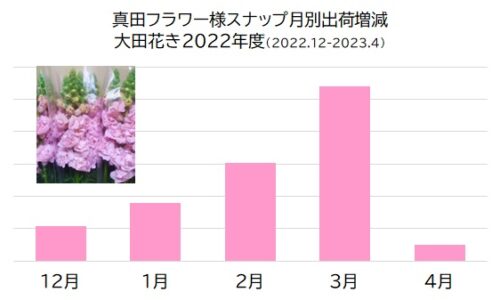
[Chart of monthly production of Snapdragon from Sanada Flower in Otakaki between December 2022 and April 2023]
Double-petal varieties are his favourites!
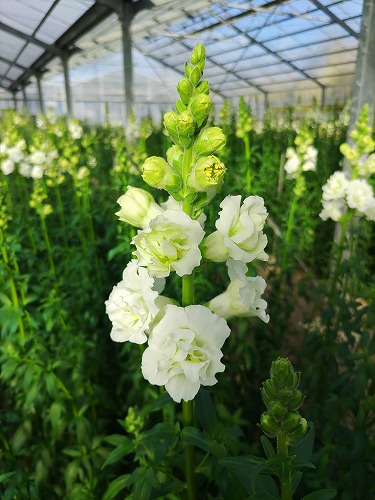
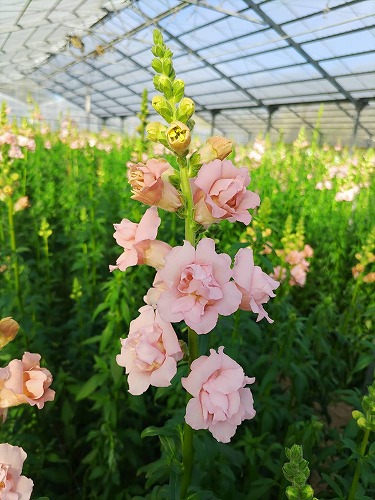
[Double-Petal Snapdragons]
★Sanada Flower’s Principles
– Cut back on water and nutrients to grow a hungry, steel-like boxer!
What sets Sanada Gomphrena globosa apart is its “wire-like stems.” Let the ground dry out and crack, and cut back on water extensively. Just like a boxer before a match, this method creates a robust plant. And that’s how they win. (*Note: This method depends on Mr. Sanada’s soil conditions in the field.)
– Because times and trends change, it’s essential not to fixate on specific items. This is Mr. Sanada’s philosophy.
Now then, everyone, goodbye and take care.
